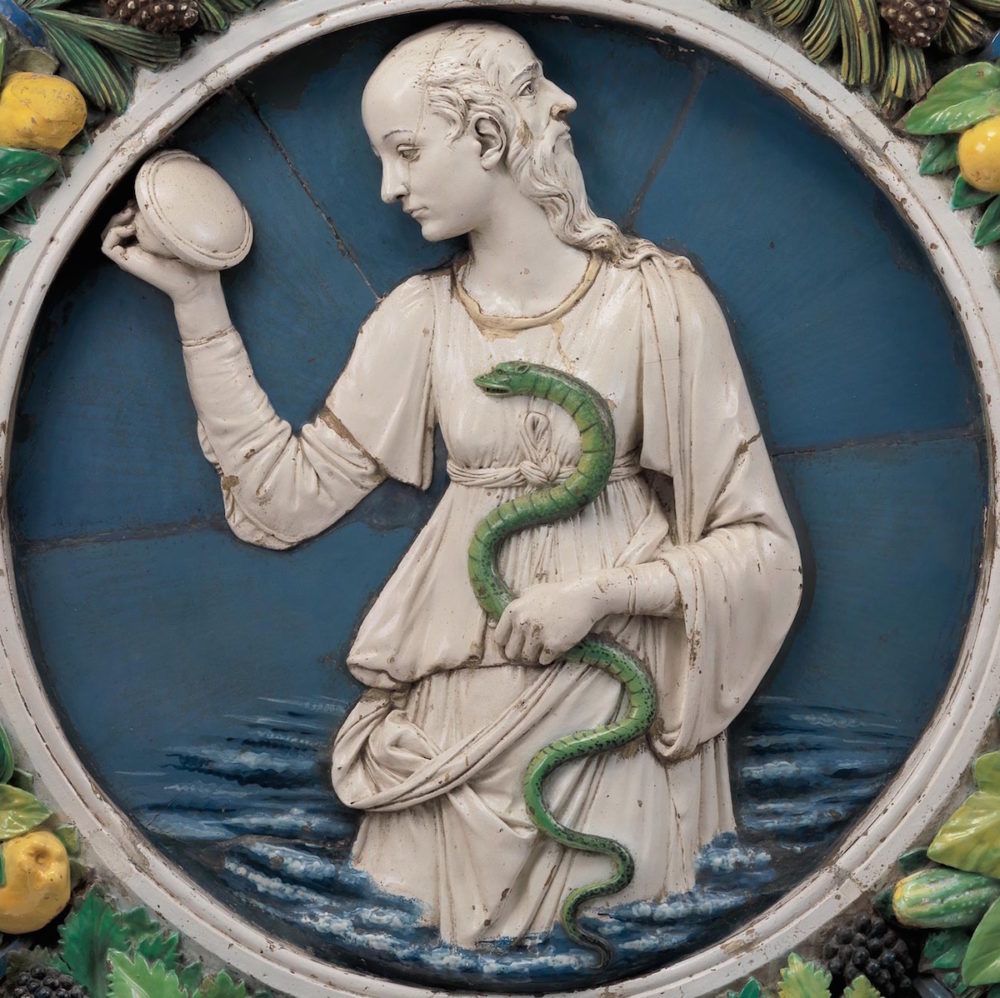BOSTON — The Della Robbia workshop in Florence, Italy had a recipe for a secret glazing technique, now lost to history. This process was so effective that today — half a millennia later— their works retain their pristine whites and colors. Della Robbia: Sculpting with Color in Renaissance Florence (Boston, August 9 – December 4) couldn’t be more aptly named. The exhibition is supported by some very careful conservation efforts that took more than a year to complete and you can see videos to that effect in the link above.
Above image: Andrea Della Robbia, Prudence (pictured prior to conservation efforts), ca. 1475, glazed terracotta. Photographs courtesy of Art Resource NY.

Andrea Della Robbia, Madonna and Child with Cherubim, ca. 1485, glazed terracotta. Photograph by Lee Ewing. Click to see a lager image.

Giovanna Della Robbia, Resurrection of Christ, ca. 1520-24, glazed terracotta. Click to see a larger image.

Giovanna Della Robbia, Dovizia (Abundance), ca. 1520, glazed terracotta. Photograph by Bridgeman Images.
In the 15th century, Luca della Robbia (1399/1400–1482) invented a glazing technique for sculpture characterized by brilliant opaque whites and deep cerulean blues, according to the museum. Luca shared the secrets of his technique with his nephew and principal collaborator Andrea della Robbia, who in turn passed them on to his sons Giovanni, Luca the Younger, Marco, Francesco, and Girolamo. The Della Robbia family workshop flourished in Florence for about a century, producing expressive artworks for all spheres of life. Portraying both sacred and secular themes, it gained a strong presence in public spaces—from street corners to churches—and private homes. Production of sculpture using this technique lasted only about a century before its secrets were lost. Some of the most familiar images today of Renaissance Italy, Della Robbia sculptures have retained their original color and shine over the centuries.

Andrea Della Robbia, Bust of a Boy, ca. 1475, glazed terracotta. Photograph by Antonio Quattrone. Click to see a larger image.

Luca Della Robbia, The Visitation, ca. 1445, glazed terracotta. Church of San Giovanna Fuorcivitas. Photograph courtesy of Scala/Art Resource NY. Click to see a larger image.

Santi Buglioni, Saint JOhn of Capistrano, ca. 1550, glazed terracotta. Photograph from Museum Associates/LACMA. Licensed by Art Resource.

Andrea Della Robbia, Roundel with Head of a Youth, ca. 1470-80, glazed terracotta. Photograph by Bridgeman Images. Click to see a larger image.
Della Robbia: Sculpting with Color in Renaissance Florence presents these works as powerful, expressive examples of the best of Italian Renaissance art. The exhibition features about 50 objects, mostly from American collections but including six important loans from Italy, never seen in the US before. The Visitation (about 1445) from the church of San Giovanni Fuorcivitas in Pistoia and the Brooklyn Museum’s newly restored Resurrection of Christ (about 1520–24) travel to Boston along with a trio of nearly life-size works from the Los Angeles County Museum of Art, the Uffizi Gallery in Florence and a private collection. The exhibition of glazed terracotta Renaissance works by the Della Robbia and rival workshops spans a variety of formats—Madonna and Child reliefs, small- and large-scale figures, narrative reliefs, coats-of-arms, and still-life compositions—that demonstrate the range and visual impact of the groundbreaking Della Robbia glazing technique.
Text (edited) and photographs courtesy of the museum.
Do you love or loathe these works of (not quite) contemporary ceramic art? Let us know in the comments.




Ever since a great tour to Italy in 1975, organized by the American Phil Gearheart, the best ceramics teacher I had at the Royal Academy of Art in ‘s-Hertogenbosch in the Netherlands, I’ve loved the gentle subtlety of the Della Robia’s in their togetherness of form and appearance of that lovely (majolica) glazing technique. Participating at a show at the local museum last year, with the general theme of “Angels”, I presented my work under the title: Della Robbia revisited. Although the work was high fired porcelain, celadon, it embodied the contra spirit of their medieval approach to enrich the church and to bring knowledge to the spectator. With 4 plaques it showed the 18 most confronting and horrifing events that took place in 2015. Thinking things would get beter this year, or at least not so violent, 2016 has proven me wrong already. What a mess…..
(If interested, I can send you some pictures.)
I love the Prudence, absolute magic, an eloquent image.